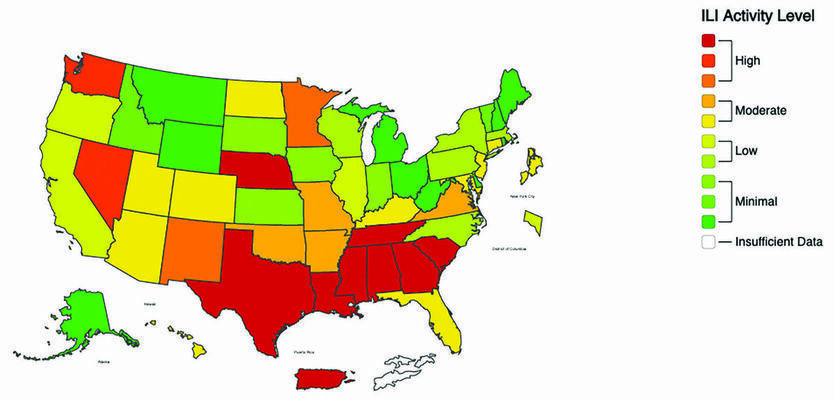Unusual flu virus contributing to early start of flu season
 Map courtesy of the CDC website
Map courtesy of the CDC website
The above map outlines the influenza like illness (ILI activity) at the end of November, with Texas already showing a high activity level.
The 2019 flu season is off to an early start compared to recent years, with health experts citing the last flu season starting this early was in 2003-04.
Not only is this season trending to peak early, but the strain circulating is influenza B, which isn’t considered a good or bad strain, just unusual.
There are three types of flu strains that infect humans-A, B and C. Strain C is generally very mild and the type A virus is the strain that normally drives most flu seasons.
The more common H1N1 and H3N2 are examples of type A. Type A viruses characteristically mutate and rearrange quickly making it harder for immune systems to recognize and combat.
This mutation has, so far, created 18 Ha and 11 Na subtypes and generated over 190 possible combinations of the flu virus that can infect humans, mammals and birds.
Type B viruses, which is leading the charge in this flu season, was first discovered in the 1940s and make slow genetic changes.
Type B viruses are most often detected in children and do not infect birds like the type A strain. As this strain has been relatively low in recent flu seasons, this could result in a lower immunity in the overall population.
According to the Centers for Disease Control & Prevention (CDC)’s website, Puerto Rico and 12 states were showing high influenza like illness (ILI activity) at the end of November, with the peak of flu season still looming on the horizon. Those states showing high ILI activity are Texas, Alabama, Georgia, Louisiana, Minnesota, Mississippi, Nebraska, Nevada, New Mexico, South Carolina, Tennessee and Washington.
Miranda Pierce with UT Health’s infection control department confirmed that east Texas is being hit with flu earlier than usual this season as well.
“We usually don't get these kinds of numbers until mid-January, typically,” said Pierce. “Right now, we're seeing primarily Flu B cases, but we are starting to see some testing positive for Flu A. However, we're not seeing large numbers of people being admitted to the hospital with flu, which is good.”
Prevention
When it comes to preventing the flu, there are several steps individuals can take, with hand washing leading the way. When soap and water are not accessible, an alcohol-based hand rub will do the trick. Additional steps include:
•avoid touching your eyes, nose and mouth;
•covering a cough/sneeze;
•avoid contact with sick people and limiting contact when you are feeling sick;
•clean and disinfect surfaces and objects that may be contaminated with germs; and
• if you are sick with flu-like illness, stay home for at least 24 hours after your fever is gone without the use of a fever-reducing medicine.
Vaccination
The CDC website states, “For the 2019-2020 flu season, CDC and its Advisory Committee on Immunization Practices (ACIP) recommend annual influenza vaccination for everyone six months and older with any licensed, age-appropriate flu vaccine (inactivated, recombinant or nasal spray flu vaccines) with no preference expressed for any one vaccine over another.
“Vaccination of high risk persons is especially important to decrease their risk of severe flu illness. People at high risk of serious flu complications include young children, pregnant women, people with chronic health conditions like asthma, diabetes or heart and lung disease and people 65 years and older.
“Vaccination also is important for health care workers, and other people who live with or care for high risk people to keep from spreading flu to them. Infants younger than six months are at high risk of serious flu illness but are too young to be vaccinated.
Studies have shown that flu vaccination of the mother during pregnancy can protect the baby after birth from flu infection for several months. Additionally, people who live with or care for infants should be vaccinated.”
Along with medical clinics in the area, individuals can get a flu vaccination from Brookshire Bros. in both Rusk and Jacksonville, Wal-Mart, CVS, Walgreens and the Cherokee County Public Health office located at 803 College Ave. in Jacksonville. Individuals are encouraged to call ahead to be sure the appropriate dosage is available.
High Risk Groups
Following is a list of all the health and age factors that are known to increase a person’s risk of getting serious complications from flu:
• asthma;
• neurologic and neurodevelopment conditions;
• blood disorders (such as Sickle Cell disease);
•chronic lung disease (COPD and cystic fibrosis);
•endocrine disorders (such as diabetes mellitus);
•heart disease (such as congenital heart disease, congestive heart failure and coronary artery disease);
•kidney/liver disorders;
•metabolic disorders (such as inherited metabolic disorders and mitochondrial disorders);
• people who are obese with a body mass index [BMI] of 40 or higher;
• people younger than 19 years of age on long-term aspirin- or salicylate-containing medications;
• people with a weakened immune system due to disease (such as people with HIV or AIDS, or some cancers such as leukemia) or medications (such as those receiving chemotherapy or radiation treatment for cancer, or persons with chronic conditions requiring chronic corticosteroids or other drugs that suppress the immune system)
Other people at high risk from flu include:
• adults 65 years and older and children less than 2 years old;
• pregnant women and women up to two weeks after the end of pregnancy;
• American Indians and Alaska Natives; and
• people who live in nursing homes and other long-term care facilities.
Symptoms
The flu and common cold share many of the same symptoms making it difficult to tell the difference between the two.
Both are respiratory illnesses and can cause symptoms such as a sore throat, cough, stuffy nose, fatigue and aches. The biggest difference lies with how quickly the symptoms onset. With a cold, the symptoms are gradual and generally mild, but with the flu they are abrupt. Those in high risk groups that show early signs of the flu should seek medical attention as the CDC recommends antiviral treatment as soon as possible, siting the “benefit is greatest is treatment is started within two days after illness onset.”
Individuals are encouraged to avoid the emergency room if only mildly and to call their health care provider.
However, people experiencing these warning signs should obtain medical care right away:
In children:
• fast breathing or trouble breathing;
• bluish lips or face;
• ribs pulling in with each breath;
• chest pain;
• severe muscle pain (child refuses to walk);
• dehydration (no urine for eight hours, dry mouth, no tears when crying);
• not alert or interacting when awake;
• seizures;
• fever above 104°F (in children less than 12 weeks, any fever);
•fever or cough that improve but then return or worsen; and
•worsening of chronic medical conditions.
In adults:
•difficulty breathing or shortness of breath;
•persistent pain or pressure in the chest or abdomen;
• persistent dizziness, confusion, inability to arouse;
•seizures;
•not urinating;
•severe muscle pain, weakness or unsteadiness;
•fever or cough that improve but then return or worsen; and
•worsening of chronic medical conditions.
Treatment
The flu is generally treated with antiviral medications, which can only be obtained with a prescription. This method of treatment works best when started soon after symptoms onset and may also reduce the risk of additional complications such as ear infections in children and pneumonia in adults.
This flu season the CDC has recommended four FDA-approved drugs; oseltamivir phosphate (available in generic form under the trade name Tamiflu), zanamivir (trade name Relenza), permavir (trade name Rapivab) and baloxavir (trade name Xofluza).
Treatment time will depend on which drug is prescribed, but is generally up to five days.
Please support The Cherokeean Herald by subscribing today!
